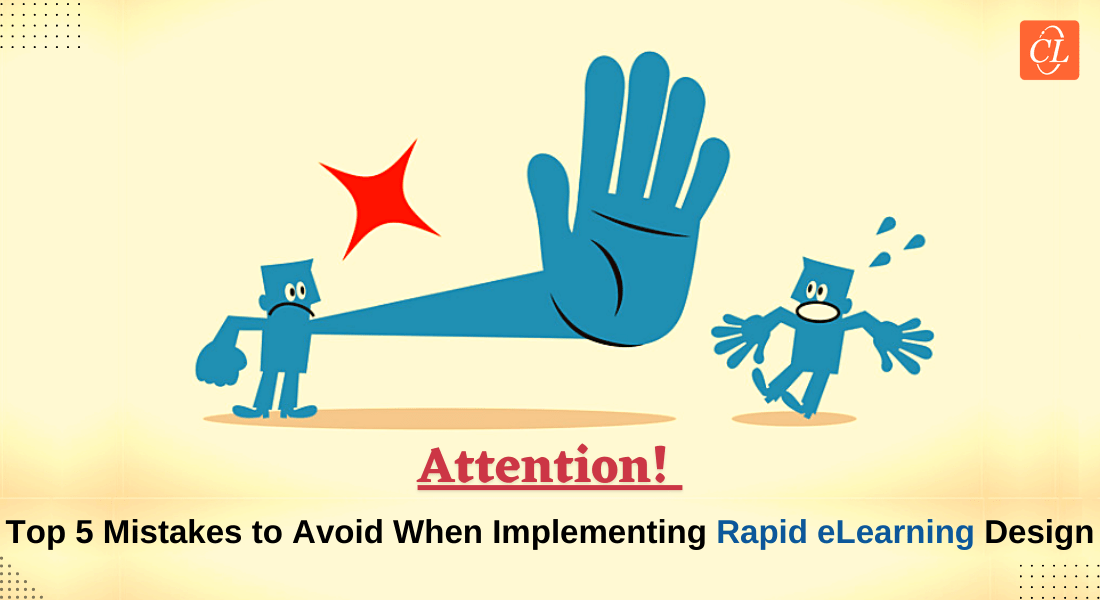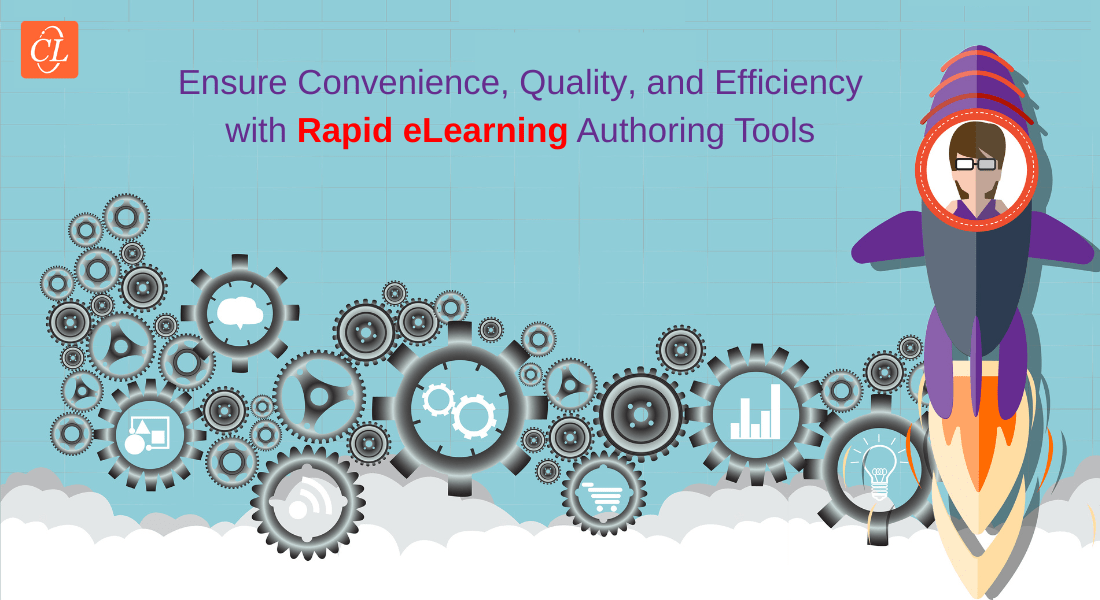5 Mistakes to Avoid When Implementing Rapid eLearning Design

Rapid eLearning design! It is an important aspect that can make or break the impact of your eLearning course, thereby influencing the effectiveness and outcome of your corporate training. With that said, there’s a catch! Highly effective training, if not delivered on time, is as good as ineffective training on time. Therefore, in today’s fast-paced world, where business goals are changing faster than ever, learning has to be both quick and efficient. To facilitate this aspect of learning, rapid eLearning design is a perfect choice. It is the process of creating high-quality, engaging eLearning content in a short amount of time. Rapid authoring tools, instructional design strategies, and a team of experts play an integral role in rapid eLearning design, enabling the development of effective eLearning modules that can be accessed by anyone, anywhere, at any time.
Attention! Avoid These Mistakes in Rapid eLearning Now!
Here’s the list:
- Trying to squeeze in too much information
- Don’t break down the content unnecessarily
- Rushing through the design process
- Not making the content digital-friendly
- Not having an assessment criteria
As important as rapid eLearning design is, it is also the aspect where mistakes are most likely to occur. Every mistake comes at a cost, and here the cost would be a disinterested, inattentive audience. So to curtail such a situation, let’s take a sneak peek at the top 5 mistakes that you should avoid when implementing rapid eLearning design.
5 Mistakes to Avoid When Implementing Rapid eLearning Design
Trying to Squeeze In Too Much Information
As an eLearning designer, it can be tempting to pack as much information as possible into a course. But one often forgets that cramming too much information into a rapid eLearning design can be overwhelming for learners and lead to a lack of retention. Instead, it’s important to focus on the key takeaways and need-to-know content to ensure that the information is presented in a clear, concise manner so that it is easy to retain and recall. Using interactive elements such as quizzes and activities helps in breaking down the information and makes it more engaging for learners. Remember, less is often more when it comes to effective eLearning design.
Check out these practical and equally effective instructional design strategies to level up your eLearning courses.
Don’t Break Down the Content Unnecessarily
Breaking down the content unnecessarily in rapid eLearning design can be like trying to navigate a labyrinth without a map. Learners may become disoriented and lose sight of the overall goal and learning objectives of the eLearning course. Instead, it’s important to organize the content in a logical and structured manner. You should use clear headings and subheadings to help learners follow the flow of information and stay on track. Additionally, you can leverage visual aids such as diagrams and flowcharts to clarify complex ideas and make the content more accessible. In rapid eLearning design, a well-organized structure is essential to guide the learners through the content, ensuring they don’t get lost in the process.
Rushing Through the Design Process
Rushing through the rapid eLearning design process is like trying to bake a cake without reading the recipe. You might end up having something that looks presentable, but there’s a high possibility that it might be missing the key ingredients and even lacking the desired taste and texture. Well, the same goes for rapid eLearning design. When you hurry through the process of designing and developing eLearning courses, you might end up overlooking the important details, and the final product may not be as impressive and effective as it could have been.
Therefore, it’s important to take some time out to carefully plan and design every single aspect of the course, from its overall structure to the individual modules and activities. These elements will help you ensure that the course is comprehensive, engaging, and effective for the learners. In a nutshell, good things come to those who take their time and pay attention to the details.
Not Making the Content Digital-friendly
When designing a rapid eLearning course, it’s important to remember that simply converting traditional classroom content into a digital format is not enough. Digital learning requires a different approach and mindset. The content needs to be adapted to the digital medium in order to be truly effective. This means you should try to make the content interactive, engaging, and visually appealing keeping in mind the various aspects of digital learning. These aspects include relevant instructional design strategies, assessments, and interactive components.
Further, it also means considering the needs of the online learners and designing the course with their learning style in mind. Failing to make the content digital-friendly is like trying to play a vinyl record on a CD player, it may work, but it’s not the best way to experience the music. Investing the time and effort to make the content digital-friendly will lead to a more effective and satisfying learning experience for the learners.
Not Having an Assessment Criteria
Not creating an assessment criteria in rapid eLearning design is a critical mistake that can negatively impact the effectiveness of the course. Without clear assessment criteria, learners will not know what is expected of them, and the course will lack the necessary structure and accountability to help them reach their learning objectives. Additionally, without assessment criteria, it becomes difficult to measure the success of the course and to identify areas that need improvement.
Incorporating assessments into the course design not only provides a way to measure the learners’ understanding of the material, but also helps to keep them engaged and motivated throughout the learning process. These assessments be formative and summative and can be in the form of quizzes, worksheets, and more. By creating assessment criteria, you set clear, measurable goals for your learners. Even better, you can track their progress to ensure that they are on track to meet those goals. It also helps the instructional designers to incorporate and arrange all elements of the eLearning course according to the assessment criteria. It helps you evaluate the effectiveness of the course and make necessary improvements.
Wrapping It Up
Rapid eLearning design is an important but equally complex process that requires careful planning and attention to detail. Mistakes can lead to an ineffective learning experience for learners. By avoiding these mistakes, you can create a comprehensive, engaging, and effective eLearning course to help your learners reach their goals. Check out our eBook for 5 effective and amazing rapid eLearnng design best practices for instructional designers.





